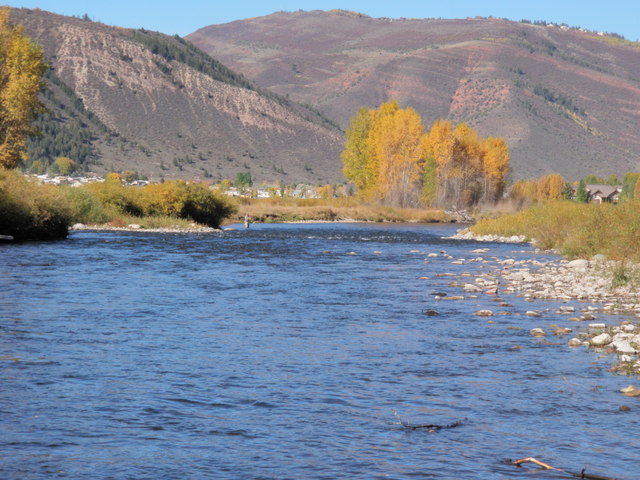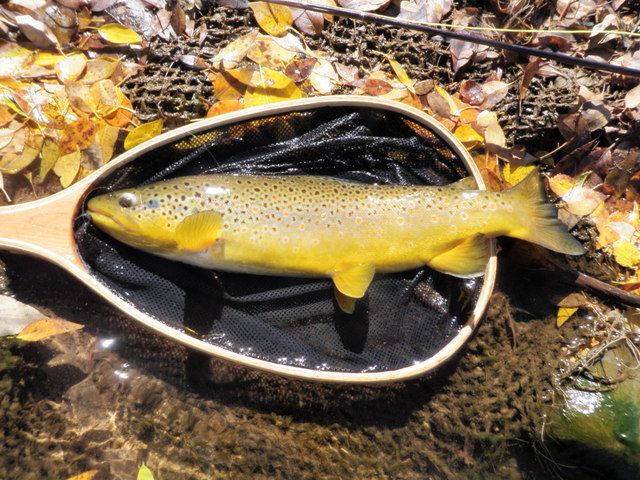Time: 10:00AM – 4:30PM
Location: The preserve near Edwards
Fish Landed: 12
Eagle River 10/07/2013 Photo Album
As I watched Dave G. and Todd land nice fish on the Eagle River on Saturday morning, September 28 at the preserve area near Edwards, I vowed to return and give this attractive stretch of river another look. I knew that Todd was leaving for California for a month on October 8, and as I examined the weather forecast I noted that Monday October 7 was forecast to be a gorgeous fall day with highs in the 70’s in Denver and low 60’s in Edwards. I fired off an email to Todd to see if he had time to fish on the day prior to his departure, and he replied that he could meet me for a few hours.
The plan was set and I would meet Todd at the preserve open space between 8:30 and 9:30AM. I got off to a nice early start and arrived in Edwards before 9AM, and as I looked at the dashboard I realized the air temperature was 31 degrees. I was reluctant to begin fishing in these subfreezing temperatures so I stopped at a coffee shop in the Riverwalk area and picked up a cup of hot tea and then sipped it for 20 minutes. By 9:30 the temperature moved to 36 degrees so I prepared to fish. Fortunately the sun was bright and the radiant energy made me feel much warmer than the thirties so I wore a long sleeve undershirt, fishing shirt and raincoat, and this served me well during the morning.
I elected to use my Sage 4 weight fast action rod as I planned to do quite a bit of nymph fishing so I removed my tapered leader and rigged for nymphing using the technique that Dave G. and I learned from Taylor Edrington. I tied a six inch section of 0X monofilament to the end of the fly line and then used a clinch knot to tie the other end to a Thingamabobber. Next I clipped a new five foot length of 3X and tied that to the Thingamabobber as well, and then extended the 3X section another foot with 5X. I crimped a split shot above the surgeon’s knot and then tied on a beadhead hares ear and below that a beadhead pheasant tail.
As I was configuring my line Todd arrived and when he was set up we hiked to the river together. Todd elected to hike down the south side of the river behind the gravel quarry and fish the deep riffle stretch where he’d done well on September 28. Meanwhile I crossed to the north side and went downstream to the bottom of the first deep run, and I fished upstream in the slow water between the fast current and the bank. I diligently fished the nymphs for quite awhile, but didn’t receive any action so I exchanged the beadhead pheasant tail for a RS2. Eventually I landed three small trout, one rainbow and two browns, on the hares ear but these fish were only seven inches in length.
As the air temperature warmed I hooked a somewhat larger brown, but it slid free of the hook and got foul hooked on the trailing RS2, and then I landed an eleven inch brown for my best fish of the morning. I’d landed four fish, but they were small and I was yearning for something bigger. I decided to cross the river and meet Todd to see how he was doing and then return to the car for lunch at around noon. When I met Todd I discovered that he was having another productive morning with twelve fish landed and quite a few in excess of fifteen inches including a 15 inch brown and some large rainbows. Todd announced that he needed to return to his house to pack and prepare for his trip, so we returned to the parking lot and I ate my lunch while he removed his waders and packed up his fishing gear.
After lunch I decided to head to the stretch of water that Todd fished and stayed with the nymphing set up. Todd also mentioned that he was catching most of his fish with a flashback pheasant tail with no bead so I made sure I had a few of these in my fleece pouch before I returned to the river. When I found the location of Todd’s success I knotted on the flashback pheasant tail and began to cover the water with casts starting with the deepest water closest to my position and then fanning out systematically. The stretch of water I was in consisted of a deep riffle that spanned the entire width of the river and ran for approximately thirty yards in length. There was a deep trough where I was standing, but the rest of the water was frankly quite nondescript with little to distinguish any part of the water from the rest.
I was probably around the middle of the long riffle and I covered the water halfway across with casts three quarters upstream and then allowed the flies to drift past me and then swing at the end. I fished the water in this manner for a half hour or so with no success and I was beginning to assume that Todd hit it at the perfect time in late morning and I was now too late. For some reason, however, I decided to wade out a bit further into the riffle that I’d just fished and made some very long casts to within ten feet of the north bank. I gave the line a big mend and allowed the flies to drift downstream without drag and on perhaps the fifth such cast as the indicator bobbed along a slight current seam it made an erratic slash and I instinctively set the hook.
I was pleasantly surprised to feel the pulsing throb of a fish and looked in amazement at a heavy fish thrashing near the surface. I held tight and the fish made a dive and attempted to roll on the line a few times and then it dashed downstream in the fast riffles. I allowed the line to zing from my reel and eventually the brown stopped its downstream sprint and began to come across the riffles. At this point I carefully gained line and eventually the brown came up along the south bank into the deeper trough where I initially stood to fish. After a few more head shakes and dives I lifted the snout out of the water and slid my net beneath a fine buttery yellow brown trout. I carefully waded to the bank and spread the fish on my net where I could snap a quick photograph. The fat brown extended beyond the net opening by two inches making it a 17 inch speciman and the deep yellow coloration matched the tiny yellow leaves lying on the beach behind my net. I carefully released my prize catch and watched it calmly swim back into the current and disappear.
In a state of euphoria I returned to my casting position and continued working the riffle from the middle of the river to within ten feet of the far bank. Each time I made four or five casts to cover the water, I followed up with three or four steps downstream and repeated the process in the same manner as I fished the Deschutes River for steelhead. On the next pass after moving three steps downstream another nice fish attacked my nymphs on the swing, and I fought and landed a 15 inch brown. Both fish chowed down on the flashback pheasant tail so I was really thanking Todd for bequeathing this water to me and pointing me toward the working fly.
It was too good to be true and I failed to interest any more fish as I worked to the bottom of the riffle where the water became quite shallow, so I moved back up to the top of the riffle above where I’d begun on my first and second passes. On the fifth cast to this upper riffle water the indicator paused and I set the hook and instantaneously a large rainbow rocketed from the river, but before I could get excited, I apparently didn’t lower my rod tip enough or allow enough slack because the fish was off and I reeled up a line that was devoid of a fish. I continued fishing the upper riffle and did hook and land a 12 inch rainbow that put up a valiant fight but it paled in comparison to the one that got away.
I now decided that Todd and I probably exhausted the golden riffle for the day so I clipped my flies to the keep and moved upstream to the next nice riffle stretch. Unfortunately this didn’t produce any fish nor did the next one and I now arrived at water that was faster and consisted of much more typical brown trout water with many pockets and deep runs and short riffles between protruding rocks. This water was more difficult to fish effectively with the nymph set up so I decided to remove it all and convert to a tapered leader with a Chernobyl ant and then the same two nymphs that I used in the riffles. It took awhile to make the conversion but eventually I was back in business and began prospecting the three fly combination. The sun was now high in the sky and it actually became a pleasant but cool afternoon in the Rocky Mountains.
Over the course of the remainder of the day between 2PM and 4:30PM I landed five more fish but these were largely 7-8 inch fish and mostly rainbows. It was nice to have more action but the results did not match my expectations particularly as I was fishing the type of water that normally delivers nice brown trout in the 12-15 inch range.
How can I explain the concentration of action to one continuous wide long deep riffle? My theory is that the brown trout are schooling up for spawning and the riffle water type represents the preferred structure for a brown trout reunion. Perhaps the rainbows are tagging along in hopes of scooping up some brown trout eggs? The fish that remain in the habitat occupied by large browns earlier in the season are juvenile browns and rainbows. This was likely my last trip to the Eagle River in 2013, but I’m anxious to give it another try in 2014 when the circumstances are more normal and not impacted by the spawning urge.
The seventeen inch brown made it a memorable day along with the colorful Aspen leaves and the cool yet pleasant temperatures. I plan to return to the preserve open space and explore again.


